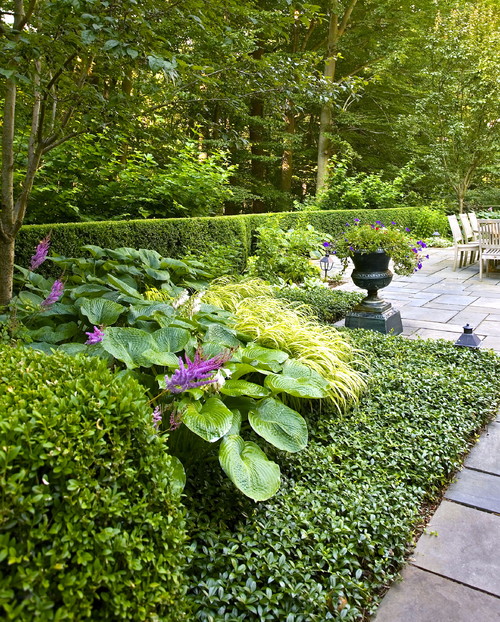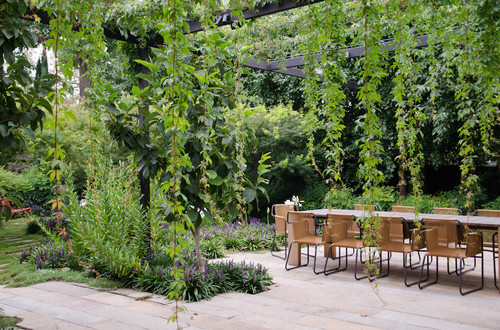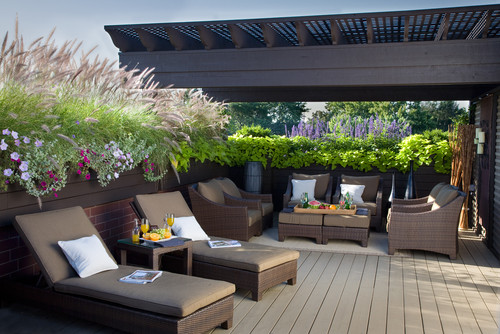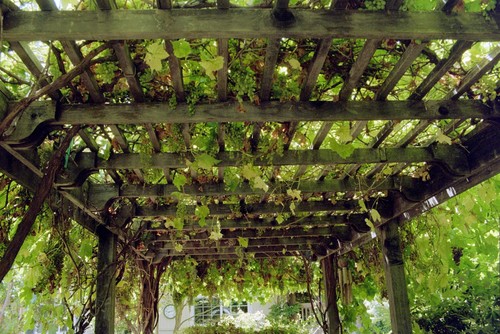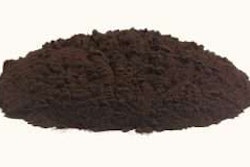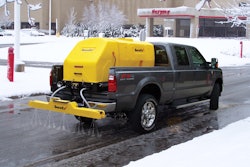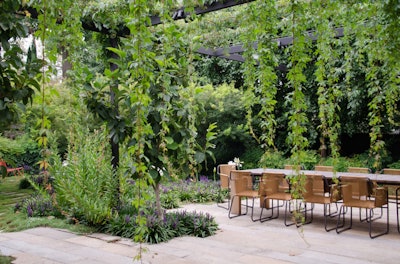
By Falon Mihalic/Houzz contributor
Vines are special because they can grow in ways that shrubs and trees simply cannot. For this reason, vines have great potential to be long-term foundation plantings in the landscape and can be used in many different ways.
Vines spread by climbing, attaching or twining their way up vertical surfaces or over the ground, and easily fill in spaces where other plants won’t grow. They can cover a trellis with vegetation and flowers or reach high over a tall fence. Here are five additional, and less conventional, ways to use vines for an even better garden experience.
1. Dense ground cover. Many vines can be grown as ground covers if maintained at a low height with regular pruning. Using a vine as a ground cover can work great in areas where it’s difficult for grass to grow or in areas that are prone to erosion. Because vines often spread and creep, they can be especially good at helping to curb erosion on steep slopes.
Robust vines with woody stems are the easiest to establish as ground covers. Carolina jessamine (Gelsemium sempervirens), which is native to the Southeastern United States, makes a dense evergreen ground cover. Common periwinkle (Vinca minor) fills out around Hosta ‘Lady Isobel Barnett’ in this New York garden.
2. Curtain of leaves. Vines can produce trailing stems when given enough room to grow downward and trail over a support. In this Melbourne, Australia, garden, a gentle cascade of Virginia creeper (Parthenocissus quinquefolia) hangs from a trellis structure. Imagine how great it looks when put in motion by a gentle breeze.
Vines with fine foliage and tendrils work best for this airy effect. Clematis species with smaller flowers, such as whiteleaf leather flower (Clematis glaucophylla), or eastern U.S. native trumpet honeysuckle (Lonicera sempervirens), are good specimens.
3. Annual color. Vines can also provide a garden with annual color. On this rooftop deck in Chicago, chartreuse-colored sweet potato vine (Ipomea batatas) fills in lots of seasonal color. It’s heat-tolerant and fast-growing all summer. As an annual, it’s an easy vine to use for containers or as a filler in existing beds. Other easy-to-grow annual vines include fragrant sweet pea (Lathyrus odoratus) and morning glory (Ipomea spp.).
4. Wall pattern. Any twining vine can wrap itself around metal cables arranged in a pattern to produce an attractive look. Here, confederate jasmine (Trachelospermum jasminoides) twines itself around metal cables on a Melbourne home’s wall to create a crisscrossing diamond pattern.
To achieve this effect, the cable size has to be small enough in relation to the size of the twining stems. The vines have to be initially guided directly onto these cables so they grow correctly. Once established in the pattern, the twining vine stems will continue to wrap around the cables. Prune regularly to keep the vine dense with foliage and the pattern visible.
5. Edibles on a pergola. Growing vines over an arbor or a pergola is an obvious choice, so why not add the extra benefit of growing something you can eat? Edible vines grown over a pergola keep fruits within easy reach by containing the vine in an overhead structure for harvest.
Vines with edible fruits include grapes (Vitis spp.), purple passionflower (Passiflora incarnate), and hardy kiwi (Actinidia arguta). For more inspiration, check out what’s growing in your local community garden this summer. You may be surprised to see all sorts of fruiting vines trained onto pergolas.
EDITOR’S NOTE: This article is from Houzz. Mihalic is a landscape architect in Texas and Florida and owner of Falon Land Studio LLC.
